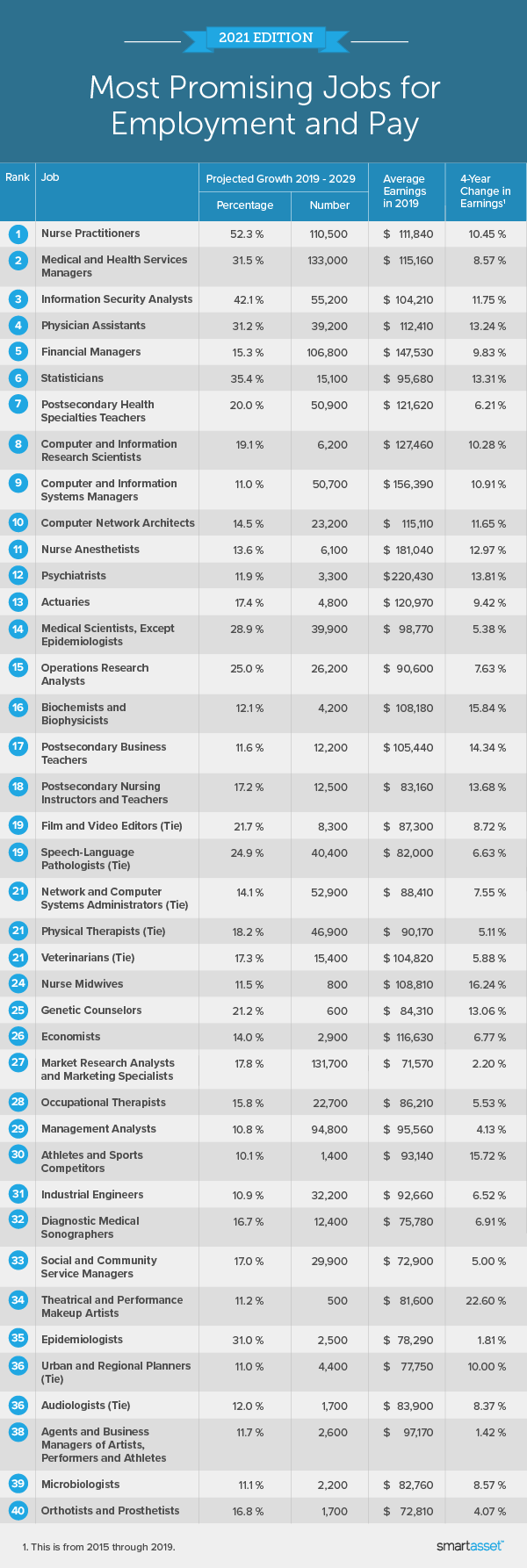The COVID-19 crisis has significantly affected the U.S. job market, and its impact will likely be felt for some time. After publishing 2019-2029 job projections in the fall of 2020 that did not capture the effects of the COVID-19 pandemic, the Bureau of Labor Statistics (BLS) issued alternate scenarios that model how jobs might be impacted if COVID-19 continues to have a moderate impact on the economy vs. a strong one. Across all occupations, job growth is expected to be almost one percentage point lower in the moderate impact scenario (2.9% vs. 3.7%) and close to two percentage points lower in the strong impact scenario (1.9% vs. 3.7%).
Though long-term job growth is muted in those scenarios and many jobs may be negatively affected going forward, there are still others that offer stable opportunities. In this study, we rank the most promising jobs for employment and pay, using the below methodology.
Data and Methodology
We filtered a total of 808 occupations detailed by the BLS by those with greater than 10% projected growth in employment (according to the moderate pandemic impact scenario) over the next 10 years. We also filtered by occupations with 2019 mean earnings greater than $64,240 (which is the 75th percentile of annual earnings nationally). The remaining 40 jobs are the most promising for employment and pay.
To rank those jobs further, we considered four metrics: 10-year expected percentage growth in employment, 10-year expected growth in number of workers, 2019 average earnings and four-year growth in earnings from 2015 to 2019. Both the 10-year expected percentage growth in employment and 10-year expected growth in number of workers are from the BLS’ moderate impact scenario.
We ranked each occupation in those four metrics, giving each an equal weighting. We then found each occupation’s average ranking and used the average to determine a final score. The occupation with the highest average ranking received a score of 100. The occupation with the lowest average ranking received a score of 0.
Key Findings
- The occupation of nurse practitioners stays in the top spot. In the latest version of our study, the most promising occupation for employment and pay was nurse practitioners. It ranks first again, placing in the top 15 occupations for all four metrics we considered. In fact, nurse practitioners has the highest 10-year expected percentage growth in employment (52.3%) and third-highest 10-year expected growth in number of workers (110,500 workers).
- In general, STEM fields are doing well. These are the three occupational categories that comprise the most top-ranking jobs for employment and pay:
– Healthcare practitioners and technical occupations (13 of 40 jobs)
– Computer and mathematical occupations (7 of 40 jobs)
– Life, physical and social science occupations (6 of 40 jobs) - Two management occupations rank in our top 10. Though the category of management occupations is not a top-3 category, two occupations within this category rank in our top 10. They are financial managers and computer & information systems managers. Both occupations have high average earnings in 2019, at $147,530 for financial managers and $156,390 for computer & information systems managers.

Healthcare Practitioners and Technical Occupations
Across the 40 occupations that are most promising for employment and pay, 13 of them fall under the category of healthcare practitioners and technical occupations. Two closely related jobs – nurse practitioners and physician assistants – rank at the top, in the No. 1 and No. 4 spots, respectively. Though average earnings for physician assistants are slightly higher than average earnings for nurse practitioners ($112,410 vs. $111,840), the number of nurse practitioners is expected to grow more quickly over the next 10 years. The BLS predicts that there will be 110,500 more nurse practitioners in 2029 than 2019, or a growth rate of 52.3%. In comparison, the 10-year expected percentage growth and growth in number of workers for physician assistants are 31.2% and 39,200, respectively.
The two highest-paying jobs across the 40 most promising for employment and pay fall in the category of healthcare practitioners and technical occupations. They are psychiatrists and nurse anesthetists. According to BLS data, average earnings for psychiatrists were $220,430 in 2019 while average earnings for nurse anesthetists stood at $181,040.
Computer and Mathematical Occupations
Four computer and mathematical occupations rank in our top 10 most promising jobs for employment and pay, while an additional three rank in our top 40. The top-ranking computer and mathematical occupations include information security analysts, at No. 3, and statisticians, at No. 6. From 2015 to 2019, average earnings for information security analysts and statisticians grew by 11.75% and 13.31%, respectively. Additionally, looking forward, the BLS expects that employment of information security analysts and statisticians will increase by 42.1% and 35.4%, respectively, over the next 10 years.
The five other computer and mathematical occupations that are most promising for employment and pay include:
- Computer and information research scientists
- Computer network architects
- Actuaries
- Operations research analysts
- Network and computer systems administrators
Though earnings for these five occupations range from about $88,400 to roughly $127,500, all five jobs have seen earnings increase over the past several years. According to BLS data, the four-year growth in earnings exceeds 7% for all five occupations. Though the BLS does not predict forward-looking pay estimates, it does estimate that employment will grow by at least 14% for all five occupations from 2019 to 2029.
Life, Physical and Social Science Occupations
Six of the 40 most promising jobs for employment and pay fall in the occupational category of life, physical and social science. They include:
- Medical scientists (except epidemiologists)
- Biochemists and biophysicists
- Economists
- Epidemiologists
- Urban and regional planners
- Microbiologists
Across those six occupations, economists have the highest average earnings ($116,630), while biochemists and biophysicists saw the greatest four-year change in pay, with average earnings increasing by almost 16%.
Over the coming 10 years, employment in each of the six occupations is expected to grow by upwards of 11%. In light of the COVID-19 pandemic, the BLS predicts that from 2019 to 2029, the number of epidemiologists in the U.S. will increase by 31.0%, the sixth-highest rate for this metric across all 40 occupations. The occupation of medical scientists (not including epidemiologists) follows closely behind, with an expected 10-year growth rate of 28.9%.
To note, this is SmartAsset’s second study on the most promising jobs for employment and pay. Check out the previous edition here.
Tips for Putting Your Paycheck to Work
- Invest early. By planning and saving early you can take advantage of compound interest. Take a look at our investment calculator to see how your investment can grow over time.
- Contribute to a 401(k) or IRA. A 401(k) is an employer-sponsored defined contribution plan in which you divert pre-tax portions of your monthly paycheck into a retirement account. Some employers will also match your 401(k) contributions up to a certain percentage of your salary, meaning that if you chose not to contribute, you are essentially leaving money on the table. Our 401(k) calculator can help you determine what you saved for retirement so far and how much more you may need. If your employer does not offer a 401(k) plan, an IRA is another great option.
- Consider professional help. A financial advisor can help you make smarter financial decisions to be in better control of your money and navigate the current market. SmartAsset’s free tool matches you with financial advisors in your area in five minutes. If you’re ready to be matched with local advisors that will help you achieve your financial goals, get started now.
Questions about our study? Contact us at press@smartasset.com.
Photo credit: ©iStock.com/SDI Productions
